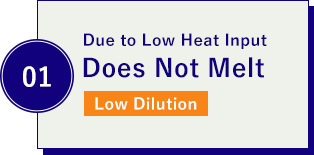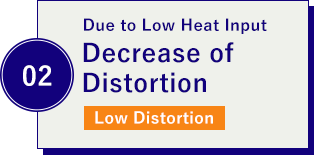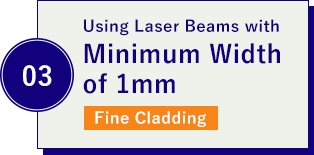The 3 Qualities of Laser Cladding



The Characteristics of Direct Diode Laser Cladding
01
Does Not Melt, Due to Low Heat Input
Comparison at Stellite®6 Claddings
Comparing Plasma Transferred Arc Cladding with Laser Cladding: Stellite®6 Cladded layer of 3mm


Compared with PTA Cladding, Laser Cladding’s penetration depth is only 1/5, obtaining higher purity and higher hardness.
02
Decrease of Distortion Due to Low Heat Input
Laser Cladding on a Hydraulic Pump Component
By using Laser Powder Cladding on a Piping component for hydraulic pumps, cladded layer of low distortion is produced. Additionally, by adjusting the diameter of the laser beam, the cladding width is controlled, causing the required amount of cladding to be cut down

Cladding Material: Stellite® 12 (corrosion and wear resistant Cobalt alloy) / Base Material: SUS630
03
Small area can be cladded by using beam size of φ1mm
Stellite® Alloy Laser Cladded Small Scale Ring Piece
Exterior of the Laser Cladding

Near Net Cladded just at the Base Material Surface

φ31.5 OD x 25mm thick
Cross section of Laser Cladding

(Oxalic Acid Electrolytic, Nital etching)




Microstructure in the vicinity of the Laser Cladding
Expected Effects
・By using near net Laser Cladding, reduction in post cladding machining volume
・Improvement in performance due to the low heat input and low dilution of Laser Cladding create surface modified layer of high physical properties and high quality.
Comparison with Thermal Spraying
Thin Laser Cladding Coating
Suppressing the dilution of the base material through low heat input, Thin Laser Cladding Coating produces a layer that is only a few hundredμm thick that obtains higher peeling, corrosion, and wear resistance, compared to other thin coating method.
Stellite® 6 layer/film thickness 400μm
Thin Laser Cladding

HVOF Coating (High-Velocity Oxygen Fuel Thermal Spraying)

Higher Corrosion Resistance Expected from the Internal Quality and Low Dilution
| Primary Element | Catalog Spec | Measured Value | Dilution Ratio |
|---|---|---|---|
| Cobalt | 55% | 50.8% | 7.6% |
| Chromium | 28.5% | 27.9% | 2.1% |
| Tungsten | 4.5% | 4.2% | 6.7% |
Low porosity and low dilution ⇒Higher Corrosion Resistance
Abrasion resistance obtained through low dilution and fine microstructure

High Hardness from Low Dilution and Fine Microstructure ⇒ Corrosion Resistance

High Value Added Composite Laser Cladding
Ceramic Particle Composite Laser Cladding
Low Dilution
Fine Cladding
What is Ceramic Particle Composite Laser Cladding?
As the name states, Ceramic Particle Composite Laser Cladding is a cladding method that uses lasers. Because lasers have a heat input much lower than conventional methods, ceramic particles can be added without melting and keeping their form within the cladded layer.

Merits
1. The type of ceramic particles and matrix metal can be selected each time according to the use and objective
2. Cladded layers with the physical properties of both ceramic and metal is obtained because the ceramic particles do not melt
Examples





Sample of Usage


SNYG’s Composite Laser Cladding technology is being used on swirl vanes, a system which separates the high-temperature gas and catalysts inside oil refineries

Product Example 1
Example of Construction on Turbine Blades
Fine Cladding
Low Dilution
Using a beam with a minimum diameter of 1mm, cladding on thin and narrow base materials has become possible, as well as cladding on intricate 3D shapes!!

Product Example 2
Laser Cladded Abrasion Resistant Industrial Knives
Purpose of this Technology
Exposed to highly abrasive environments, Industrial Knives require high wear and impact resistance.
This Industrial Knife promises high abrasion resistance through Laser Cladding that densely disperses Ceramic Particles, which have higher hardness than metal, into the cutting edge surface.
Additionally, by choosing the most appropriate alloy for the metal matrix, the product obtains resistance against impact and corrosion, withstanding harsh environments.
This Industrial Knife promises high abrasion resistance through Laser Cladding that densely disperses Ceramic Particles, which have higher hardness than metal, into the cutting edge surface.
Additionally, by choosing the most appropriate alloy for the metal matrix, the product obtains resistance against impact and corrosion, withstanding harsh environments.

Magnified View of Cladded Layer

| Material | Expected Effects |
|---|---|
| Stainless | Impact Resistance, Corrosion Resistance |
| Nickel Alloy | Impact Resistance, Corrosion Resistance |
| Cobalt Alloy | Abrasion Resistance, Corrosion Resistance |
Product Example 3
Ceramic Composite Laser Cladding
What is Ceramic Composite Laser Cladding?
By using the Laser Cladding Technology, which clads at a much lower temperature than conventional systems, ceramic particles can be added without melting and maintaining its shape.

Characteristics
1. Ceramic Particle and Matrix Metal is chosen according to the utility and purpose of the product
2. Being that the ceramic particles do not melt, cladded layer that holds the physical properties of both the ceramic particles and metal is produced
